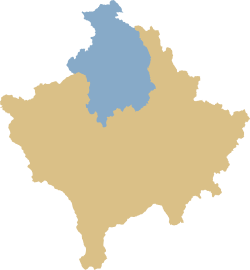Mitrovica District
| Rajoni i Mitrovicës Косовскомитровачки округ |
|
|---|---|
| District of Kosovo | |
 Location of Mitrovica District in Kosovo |
|
| Country |
|
| Capital | Mitrovica |
| Area | |
| • Total | 2,077 km2 (802 sq mi) |
| Population (2011 census) | |
| • Total | 232,833 |
| • Estimate (2014) | 272,247 |
| • Rank | 3rd |
| • Density | 110/km2 (290/sq mi) |
| Postal code | 40000 |
| Vehicle registration | 02 |
| Municipalities | 6 |
| Settlements | 267 |
Mitrovica District (Albanian: Rajoni i Mitrovicës, Serbian Cyrillic: Косовскомитровачки округ) is one of the seven districts of Kosovo. Its administrative center and the largest city is Mitrovica. The district borders on the District of Peć the south-west, District of Pristina in the south-east and east, and Serbia in the north.
The first human habitations here can be traced back to the Prehistoric period. Some Neolithic sites have been discovered in the Mitrovica District, for example in Runik, Zhitkoc and Karagac, Vallac and Fafos. This region was populated by Dardanians, an Illyrian tribe that lived in the territory of today's Kosovo.
By the end of the 1st century BC, the Romans invaded the region. At the time, one of the most important centres in the region was Municipium Dardanorum, localized in the village of Socanica, Municipality of Leposavic. Archeological sites from the Roman period were also found in the territory of Vushtrri (Vicianum), for example the ruins in the village Pestova and the Rashan Fortress.
After the Romans, the territory of Mitrovica Region was occupied by Byzantium. During the Justinian I period (527-565), the Old Fortress in Vushtrri was built, which remains the city center today. By the end of the 9th century, the Region of Mitrovica became part of the Bulgarian state of Samuel. The area was conquered by the Nemanjić dynasty in 1185. During the Serbian rule, the region and Kosovo in general became a political and spiritual centre of the Serbian Kingdom. The Ottomans came to the region in the 14th century and stayed until the 17th century. During the Ottoman invasion, Islam spread in this area and many mosques, Turkish baths, madrasah, bridges and Ottoman houses were built. The cities of Vushtrri, Mitrovica and Zvecan became some of the largest cities in the region and some of the most important in the Ottoman Empire. In 1912, after the Ottoman capitulation, Serbia conquered the territory of Kosovo. In the first World War, the region was part of the Austro-Hungarian Empire (1915–18), then part of the Kingdom of Serbs, Croats and Slovenes. In World War II, Germany conquered most of territory of the Mitrovica Region, while the Skenderaj were under Italians. After World War II, under Yugoslavia the economy in the Mitrovica region was on its culmination.
...
Wikipedia
